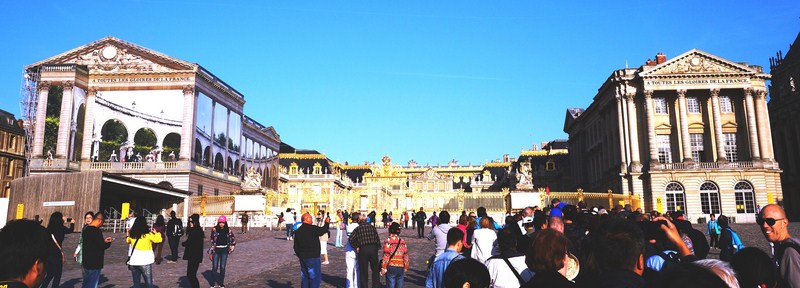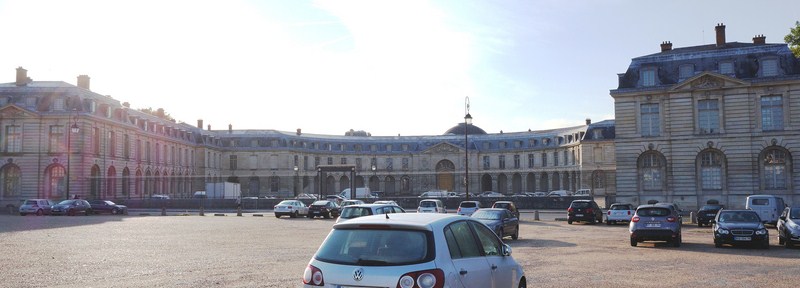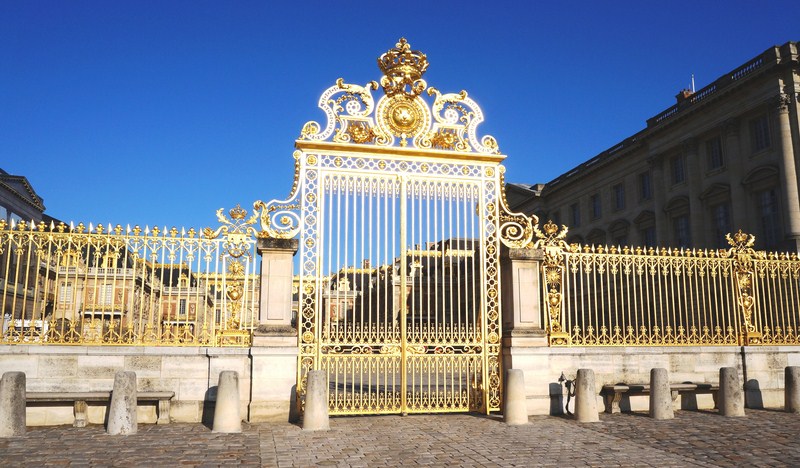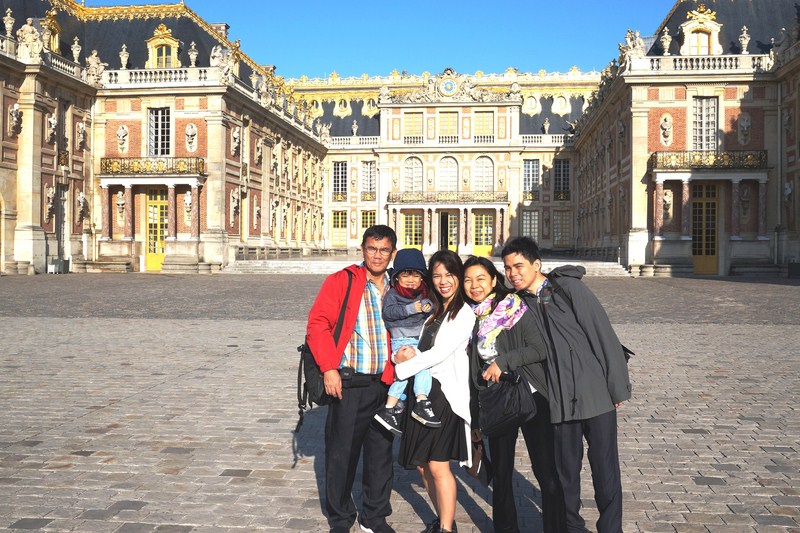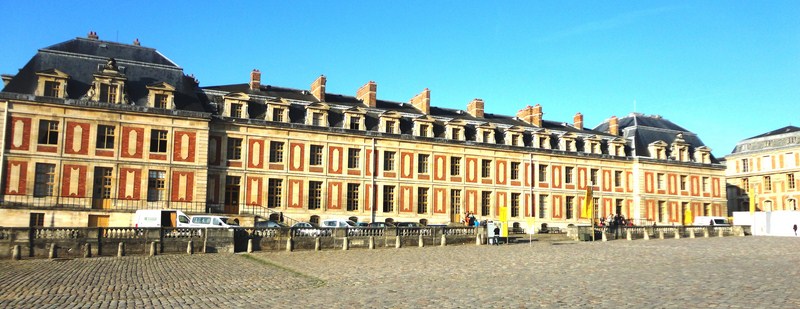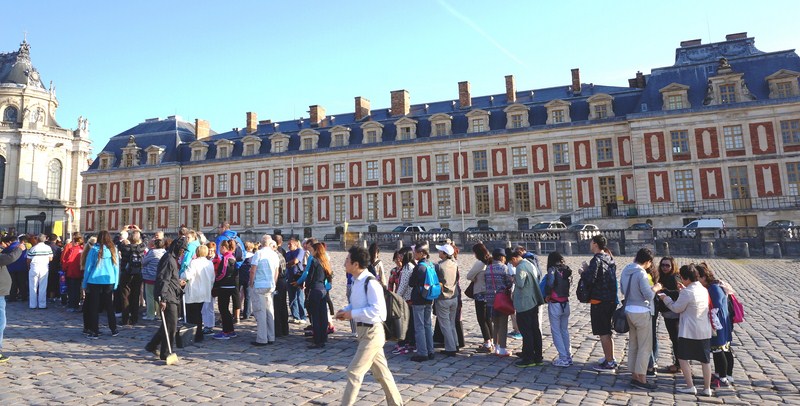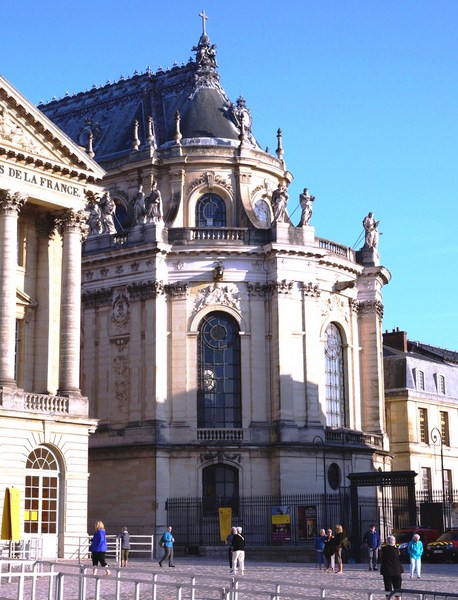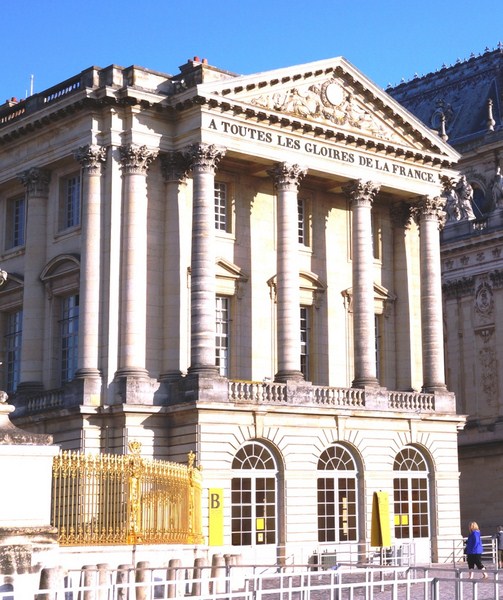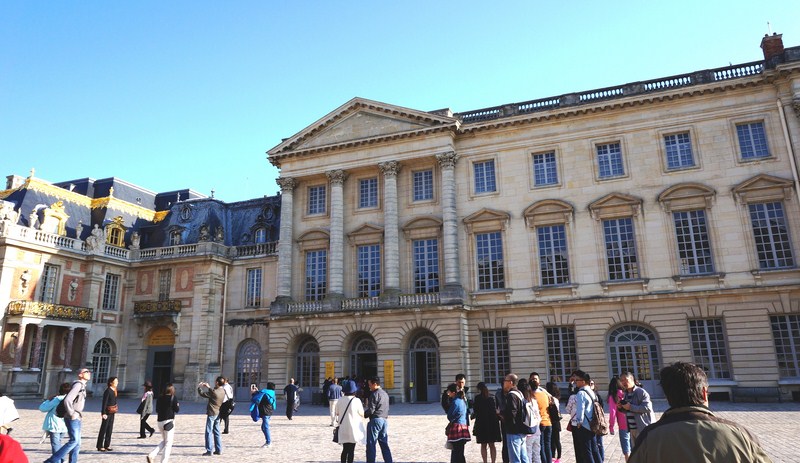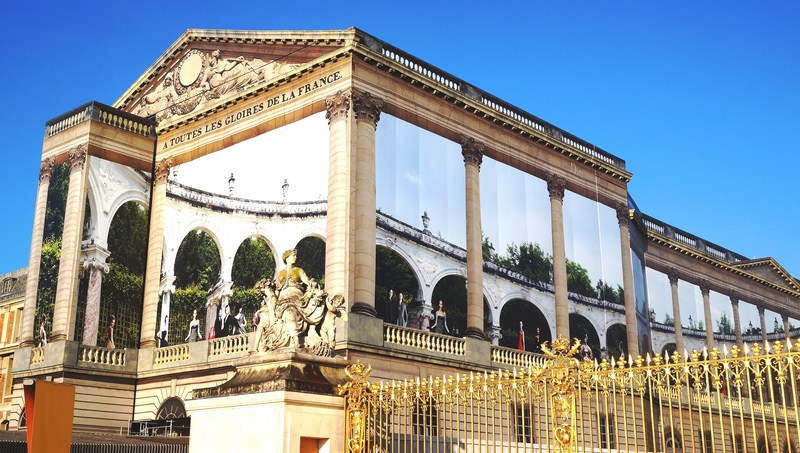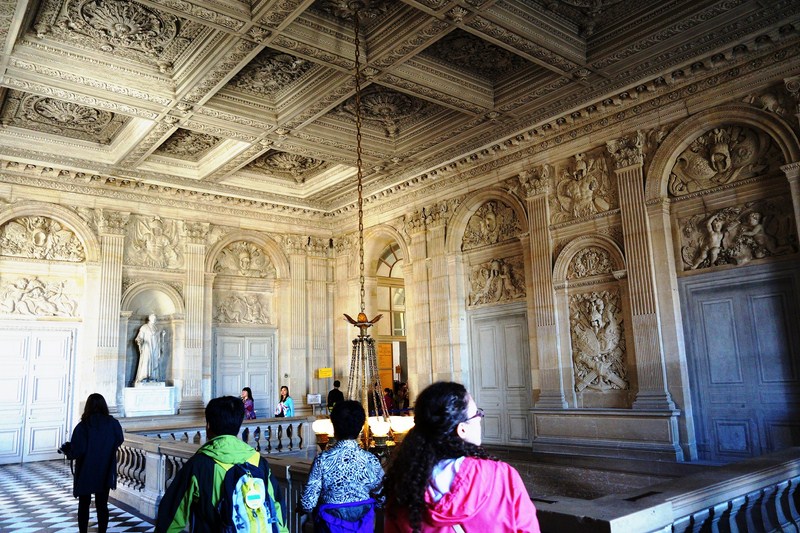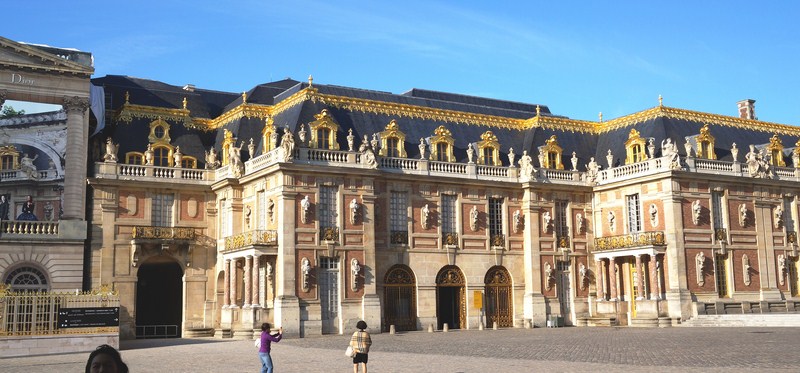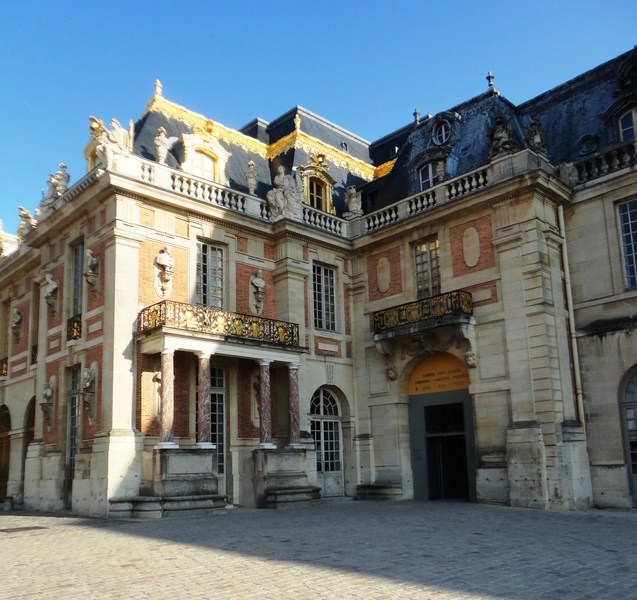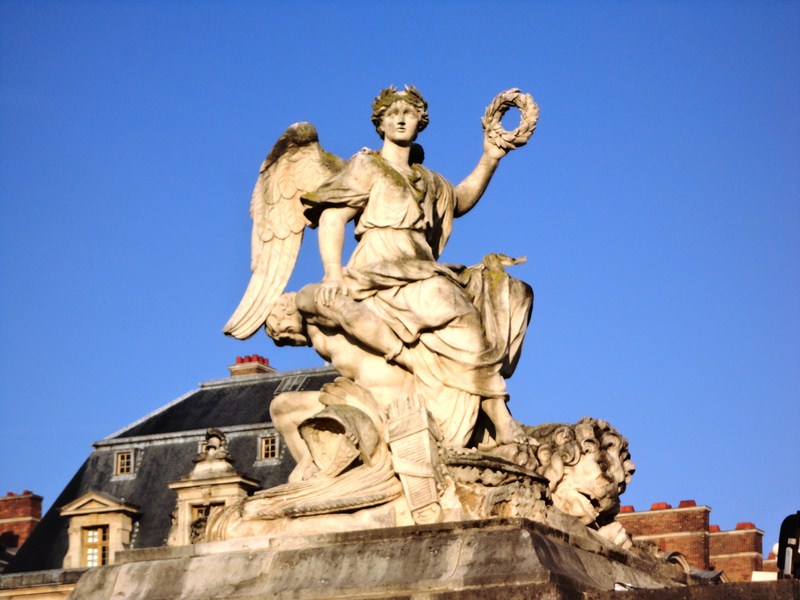After a 10-min. walk from the Versailles Château – Rive Gauche train station, we finally at the Place d’Armes, the roughly fan-shaped square with its equestrian statue of Louis XIV in the center and the Grande Écurie and the Petite Écurie (Royal Stables) to the east. We entered the Palace of Versailles via the royal gate into the Court of Honor (cour d’honneur), the courtyard in front of the palace.
The original Baroque-style steel gate, designed by Jules Hardouin-Mansart, was torn down during the French Revolution.
The new 80 m. high, recreated steel gate, decorated with 100,000 gold leaves, was unveiled last February 4, 2008 after two years of painstaking work by legions of top craftsmen and history experts with private donors contributing five million euros (eight million dollars) to ensure an exact replica would be produced. As we had already bought our tickets online, we entered the palace via Entrance A.
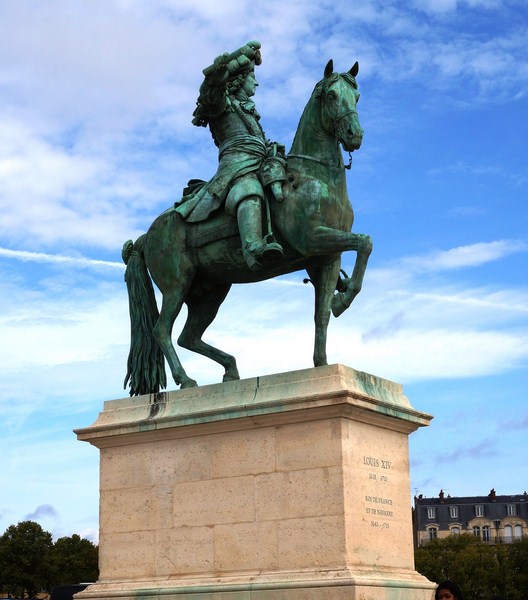
The bronze equestrian Statue of Louis XIV designed by Pierre Cartellier. The rider is the work of Louis Petitot, son-in-law of Cartelier, and the whole was cast in bronze by Charles Crozatier in 1838. The proportions of the statues of the horse and the king are slightly different. Previously located in the Cour d’Honneur, it was relocated to the Place d’Armes in 2009.
The royal court of Versailles, home of the French nobility and a symbol of the system of absolute monarchy of the Ancien Régime, was the center of political power in France from 1682 (when Louis XIV moved from Paris) until October 1789, after the beginning of the French Revolution, when the royal family was forced to return to the capital.
Here is the historical timeline of the palace:
- From 1661–1678, the first phase of the expansion into a royal palace by Louis XIV, designed and supervised by the architect Louis Le Vau, culminated in the addition of three new wings of stone (the enveloppe), which surrounded Louis XIII’s original building on the north, south, and west (the garden side). As a result of Le Vau’s enveloppe of Louis XIII’s château, the king and the queen had new apartments in the new addition (known at the time as the château neuf). Charles Le Brun designed and supervised the elaborate interior decoration. André Le Nôtre (who landscaped the extensive Gardens of Versailles) and Le Brun (who supervised the design and installation of countless statues) collaborated on the numerous fountains.
- In 1670, after Le Vau’s death, the work was taken over and completed by his assistant, François d’Orbay.
- From 1678–1715, during the second phase of expansion, two enormous wings north and south of the wings flanking the Royal Court (Cour Royale) of the main château were added by the architect Jules Hardouin-Mansart who also replaced Le Vau’s large terrace on the west (garden) front with what became the most famous room of the palace, the Hall of Mirrors. Mansart also built the stables (Petites Écuries and Grandes Écuries), on the opposite (east) side of the Place d’Armes, in front of the palace and the château known as the Grand Trianon (or Marble Trianon), replacing Le Vau’s 1668 Trianon de Porcelaine in the northern section of the palace park.
- By 1682, work was sufficiently advanced that Louis XIV was able to proclaim Versailles his principal residence and the governmental center of France, and to give rooms in the palace to almost all of his courtiers.
- In 1683, after the death of his consort Maria Theresa of Spain, Louis XIV undertook the enlargement and remodeling of the royal apartments in the oldest part of the palace, the château built by his father.
- In 1688, the Royal Chapel of Versailles, located at the south end of the north wing, was begun by Mansart.
- In 1710, after Mansart’s death in 1708, work on the Royal Chapel was completed by his assistant Robert de Cotte .
- In 1738, Louis XV remodeled the king’s petit appartement on the north side of the Cour de Marbre (Marble Court), originally the entrance court of the old château.
- In 1768, the Petit Trianon, a pavilion in the palace park designed by Ange-Jacques Gabriel, was finished.
- In 1770, the Opéra, a theater at the north end of the north wing designed by Gabriel, was completed in time for the marriage of the Dauphin (the future Louis XVI), Louis XV‘s grandson, and Marie Antoinette.
- After he became king in 1774, Louis XVI made only a few changes to the main palace, primarily to their private apartments. Marie Antoinette made extensive changes to the interior of the Petit Trianon as well as its gardens, including adding her private Théâtre de la Reine and the Hameau.
- In 1783, the three treaties of the Peace of Paris (1783), in which the United Kingdom recognized the independence of the United States, where signed in the Palace.
- On October 5, 1789, growing anger in Paris led to the Women’s March on Versailles wherein a crowd of several thousand men and women, protesting the high price and scarcity of bread, marched from the markets of Paris to Versailles. Taking weapons from the city armory, they besieged the Palace and compelled the King and Royal family and the members of the National Assembly to return with them to Paris the following day.
- In 1792, the Convention (the new revolutionary government), ordered the transfer of all the paintings and sculptures from the Palace to the Louvre.
- Between 25 August 1793 and 11 August 1794, auction of furniture, mirrors, baths and kitchen equipment, were sold in seventeen thousand lots. All fleurs-de-lis and royal emblems on the buildings were chambered or chiseled off. The empty buildings were turned into a storehouse for furnishings, art and libraries confiscated from the nobility.
- Beginning in 1793, the empty grand apartments were opened for tours and a small museum of French paintings and art school was opened in some of the empty rooms.
- In 1810, Napoleon Bonaparte, prior to his marriage with Marie-Louise, he had the Grand Trianon restored and refurnished as a springtime residence for himself and his family, in the style of furnishing that it is seen today.
- In 1820, Louis XVIII ordered the restoration of the royal apartments, but the task and cost was too great.
- In 1833, Louis-Philippe initiated effort to restore and maintain Versailles when he changed the palace when he began renovation the south wing of the Palace, which had been used to house some members of the royal family, to convert them into the Museum of the History of France, including the Galerie des Batailles (Hall of Battles) which lies on most of the length of the second floor. To give greater uniformity of appearance to the front entrance, the far end of the south wing of the Cour Royale was demolished and rebuilt to match the Gabriel wing of 1780 opposite.
- On June 30, 1837, the museum was inaugurated.
- During the Franco-Prussian War of 1870–1871, the general staff of the victorious German Army occupied the Palace and parts of the chateau, including the Gallery of Mirrors, were turned into a military hospital.
- On January 18, 1871, the creation of the German Empire, combining Prussia and the surrounding German states under William I, was formally proclaimed in the Hall of Mirrors.
- In March 1871, until the signing of the armistice with the Germans, the government of the new Third French Republic moved into the Palace. The National Assembly held its meetings in the Opera House.
- In 1892, Pierre de Nolhac, poet and scholar and the first conservator, began restoration efforts at the Palace. Though interrupted by two world wars, the conservation and restoration work still continues until the present day.
- In June 1919, the Treaty of Versailles, formally ending the First World War, was signed in the Hall of Mirrors.
- Between 1925 and 1928, American philanthropist and multi-millionaire John D. Rockefeller gave $2,166,000 (the equivalent of about thirty million dollars today), to restore and refurnish the palace.
- On April 9, 1957, further restoration of the backstage areas of Royal Opera of Versailles was completed and the Royal Opera of Versailles was reopened in the presence of Queen Elizabeth II of the United Kingdom.
- In 1978, parts of the Palace were heavily damaged in a bombing committed by Breton terrorists.
- In 1979, the palace and its garden were inscribed in the UNESCO World Heritage List.
- In 2003, the “Grand Versailles” project, a new restoration initiative, was started. It began with the replanting of the gardens which, on December 26, 1999, had lost over 10,000 trees during Hurricane Lothar .
- In 2006, the restoration of the Hall of Mirrors was completed.
Check out “Versailles Palace – Royal Chapel,” “Versailles Palace – State Apartments of the King,” “Versailles Palace – Gallery of Great Battles” and “Versailles Palace – Hall of Mirrors”
Here are some interesting trivia regarding the palace:
- The palace was originally a hunting lodge built in brick and stone by King Louis XIII in 1623.
- The land on which the palace was built on was situated on a narrow plateau with many swamps around it and not fit for the construction. For the project to happen, they needed to restructure the whole area by drying the swamps up and fill the area around the plateau with soil and stones. Earthwork and leveling were also essential for the construction to begin.
- The Palace of Versailles is the second-most visited monument in the Île-de-France region (7,700,000 visitors in 2017), just behind the Louvre and ahead of the Eiffel Tower.
- Versailles was one of the few castles in France that wasn’t located near a river so artificial ponds were created and aerial and underground aqueducts built to supply water for the Palace’s fountains and all the surrounding waters were redirected to it. They also pumped the water out of the Seine River using new techniques and hydraulic methods. A revolutionary pumping machine, built for this project, drew water from the river and, for it to reach the aqueducts that would lead the water to the Palace, drove it through pipes more than one hundred meters above the Seine level.
- The Palace was not restricted only for the King and his court and though everyone could freely visit the Palace and walk its gardens, elegance was essential in the Palace of Versailles and visitors needed to be well-dressed to be allowed to walk the Palace. Those who did not have a proper outfit, could rent one at the entrance of the Palace.
Check out “Eiffel Tower“
The palace, enthusiastically promoted as one of France’s foremost tourist attractions by the Fifth Republic, still serves political functions. Heads of state are regaled in the Hall of Mirrors and the French Senate (Sénat) and the National Assembly (Assemblée nationale) meet, in congress, in Versailles to revise or otherwise amend the French Constitution, a tradition that came into effect with the promulgation of the 1875 Constitution.
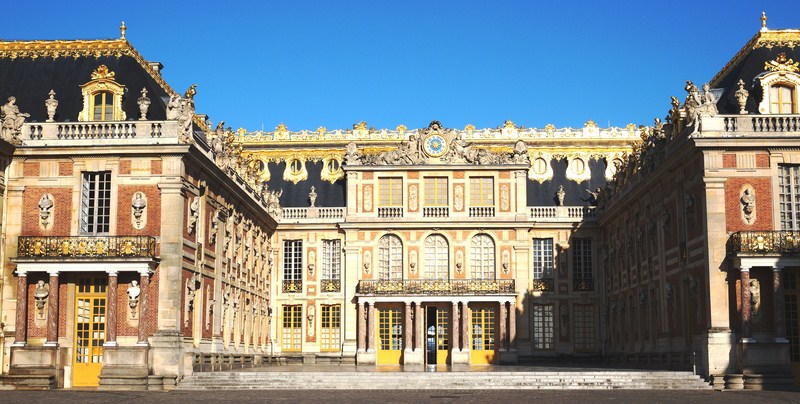
The Marble Court (made with contrasting red brick, white stone and grey slate highlighted with god decoration) and the facade of the first chateau built by King Louis XIII
The Grand Apartments (grands appartements), known respectively as the King’s Grand Apartment (grand appartement du roi), consisting of an enfilade of seven rooms, and the Queen’s Grand Apartment (grand appartement de la reine) forming a parallel enfilade with that of the grand appartement du roi, occupied the main or principal floor of the New Palace (château neuf).
Check out “Versailles Palace – State Apartments of the King” and “Versailles Palace – Queen’s Grand Apartment”
Le Vau’s design for the state apartments, closely following Italian models of the day, is evidenced by the piano nobile (a convention the architect borrowed from 16th- and 17th-century Italian palace design), the placement of the apartments on the next floor up from the ground level.
Owned by the French state, the Palace of Versailles’ formal title is the Public Establishment of the Palace, Museum and National Estate of Versailles and, since 1995, has been run as a Public Establishment, with an independent administration and management supervised by the French Ministry of Culture.
Offering a visual history of French architecture from the 17th century to the end of the 18th century, the Palace of Versailles began with the original château, with the brick and stone and sloping slate (from Angers) Mansard roofs of the Louis XIII style, used by architect Philibert Le Roy. With the addition of the colonnades and flat roofs of the new royal apartments, done in the French Classical or Louis XIV style, as designed by Louis Le Vau and, later, by Jules Hardouin-Mansart, it then became grander and more monumental. In 1768, it concluded in the lighter and more graceful Neo-Classical Louis XVI style of the Petit Trianon, completed by Ange-Jacques Gabriel.
Largely completed by the death of Louis XIV in 1715, the eastern part of the palace has a U-shaped layout, surrounding a black-and-white marble courtyard, with the corps de logis and symmetrical advancing secondary wings terminating with the Dufour Pavilion on the south and the Gabriel Pavilion to the north, creating an expansive cour d’honneur known as the Cour Royale (Royal Court).
Two enormous asymmetrical wings, flanking the Royal Court, results in a 402 m. (1,319 ft.) long facade. The palace, covered by around a million sq. ft. (10 hectares) of roof, has 2,143 windows, 1,252 chimneys, and 67 staircases.
The façade of Louis XIII’s original château, preserved on the entrance front, was built of red brick and cut stone embellishments. In the center of the courtyard is a 3-storey avant-corps fronted with eight red marble columns, supporting a gilded wrought-iron balcony and surmounted with a triangle of lead statuary surrounding a large clock (its hands stopped upon the death of Louis XIV).
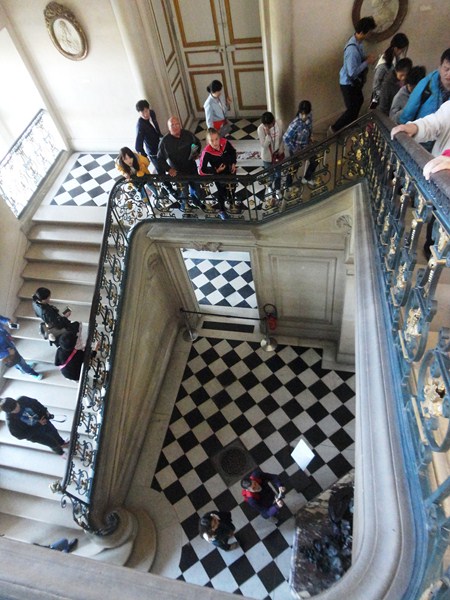
Questel Staircase, located at the North Wing, was named after architect Charles-Aususte Questel. It replaced the one built by Questel’s predecessor, Frédéric Nepveu, during the July Monarchy.
Columns, painted and gilded wrought-iron balconies plus dozens of stone tables decorated with consoles (holding marble busts of Roman emperors) completes the rest of the façade while atop the slate Mansard roof, are elaborate dormer windows and gilt lead roof dressings, added by Hardouin-Mansart in 1679–1681.
The garden front and wings, inspired by the architecture of Baroque-style Italian villas but executed in the French Classical style, were encased in enveloppe (white cut ashlar stone from L’Oise) by Le Vau in 1668-1671 and modified by Hardouin-Mansart in 1678–1679.
The exterior features an arcaded, rusticated ground floor, supporting a main floor with round-headed windows divided by reliefs and pilasters or columns, while the attic storey, with square windows and pilasters, is crowned by a balustrade bearing sculptured trophies and flame pots dissimulating a flat roof.
Chateau de Versailles: Place d’Armes, 78000 Versailles, France. Tel: +33 1 30 83 78 00. Website: www.chateauversailles.fr. Open daily (except on Mondays and May 1), from 9:00 AM to 6:30 PM. Last admission is 6 PM while the ticket office closes at 5.45 PM. The estate of Trianon and the Coach Gallery only open in the afternoon while the Park (7 AM to 8:30 PM) and Gardens (8 AM to 8.30 PM, last admission: 7 PM) are open every day. Access to the Gardens is free except on days of fountains shows. You can access the estate of Trianon through the Gardens or through the city. The Petit Trianon is only possible via the Grand Trianon.
Admission: 27 € for Passport with Timed Entry (days with Musical Fountains Shows or Musical Gardens), 20 € for Passport with Timed Entry (without musical fountains show or musical gardens), 12 € for Estate of Trianon ticket(without Musical Fountains Show or Musical Gardens), 10 € for Passport with Timed Entry (free admission, days with Musical Fountains Show or Musical Gardens), 9,50 € for Musical Fountains Show ticket, 8,50 € for Musical Gardens ticket, 28 € for the Fountains Night Show.
How to Get There: The cheapest option for reaching Versailles is by train. There are three train stations in Versailles. RER line C arrives at Versailles Château – Rive Gauche train station, the closest one of the Palace (just 10 minutes’ walk to the Palace). SNCF trains from Gare Montparnasse arrive at Versailles Chantiers train station, which is 18 minutes on foot to the Palace. SNCF trains from Gare Saint Lazare arrive at Versailles Rive Droite train station, 17 minutes on foot to the Palace. RER C and SNCF train times are available on www.transilien.com.

